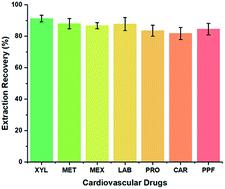Magnetic porous organic polymers for extraction of cardiovascular drugs in human urine samples followed by HPLC-UV†
Abstract
Herein, magnetic porous organic polymers (MOPs) prepared via an azo coupling reaction in water under mild conditions are evaluated for the extraction of seven cardiovascular drugs, including xylocaine, metoprolol, mexiletine, labetalol, propranolol, carvedilol and propafenone, from human urine samples for the first time. The extraction mechanisms are assumed to be electrostatic interaction and π–π stacking. The MOPs exhibited fast adsorption/desorption time (13 min) and high enrichment factors (315–365-fold) for target analytes. Based on this, a method coupling magnetic solid phase extraction with HPLC-UV detection was developed for the analysis of cardiovascular drugs. Under the optimized conditions, the LODs (S/N = 3) were in the range of 0.06–0.57 μg L−1 with an RSD (n = 5) of 4.3–8.6%, and the linear range was 0.2–200 μg L−1 for propranolol, 2–200 μg L−1 for metoprolol, and 0.5–200 μg L−1 for the other five analytes. The developed method was applied for the analysis of cardiovascular drugs in urine samples with recoveries of 89.0–112%. In order to further evaluate the application potential of this method, real-time monitoring of metoprolol in urine samples collected from volunteers treated with metoprolol tablets was performed. The proposed method is simple, fast, and sensitive and has good potential in the monitoring of cardiovascular drugs in competitive sports and clinical analysis.



 Please wait while we load your content...
Please wait while we load your content...